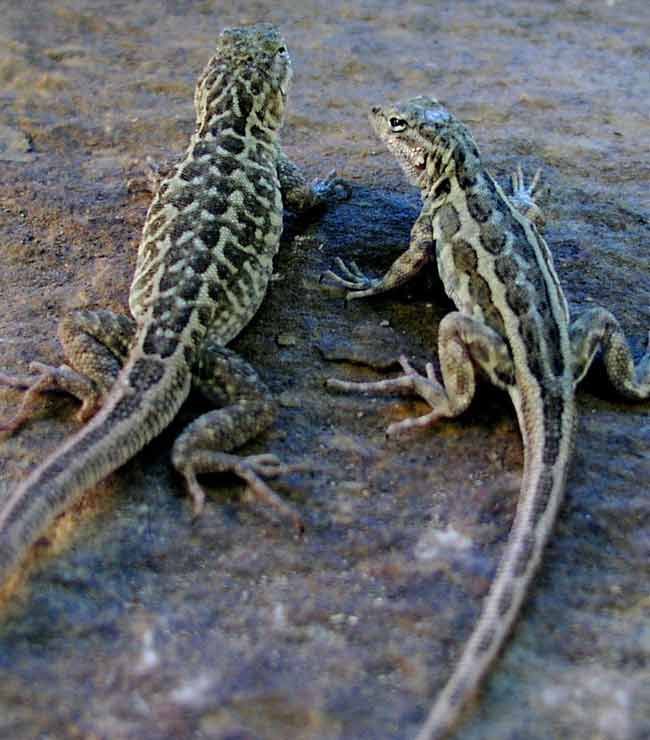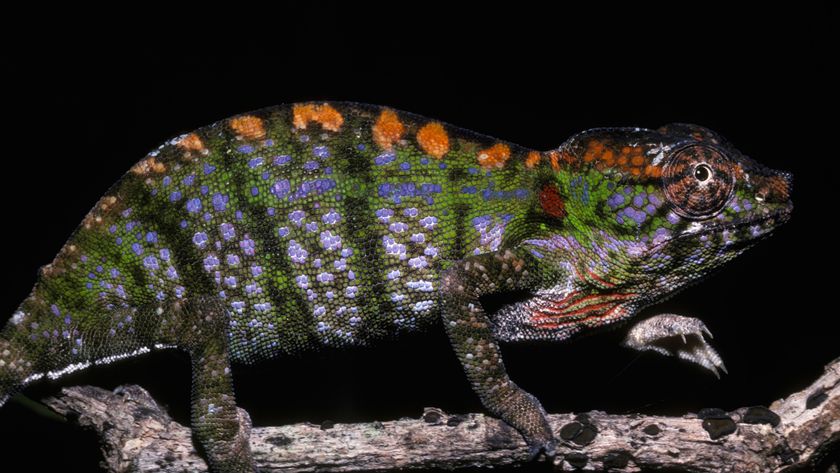Young Lizards Dressed For Success

Mothers know best when it comes to dressing their children for success, at least among side-blotched lizards. Females of this species can apparently trigger different color patterns in their offspring, "dressing" their progeny to help them best avoid predators.
The common side-blotched lizard (Uta stansburiana) is among the most abundant lizards in the arid western United States. The lizard's main predator, the coachwhip snake (Masticophis flagellum), is a very effective hunter, so the lizards need just the right combination of traits to avoid being eaten.
Specifically, the lizards need patterns on their backs that match their habitats and behavior.
For instance, yellow-throated males, which sneak into the territories of other males to mate with females, like to hide in the grass and have a pattern of bars stretching from side to side that breaks up the outline of their bodies so they blend in with the background. Orange-throated males of the same species, which are highly aggressive and usurp territory from other lizards, spend a lot of time in the open and employ lengthwise stripes down their backs to help them escape from predators, as stripes on fast-moving prey helps disrupt the outlines of their bodies, making them harder to catch.
Hormone control
The genes that control behavior and back patterns in side-blotched lizards are not linked, so a lizard could end up with a mismatch that would leave it highly vulnerable to predators, such as wearing stripes and trying to hide in the grass.
Now researchers have discovered that female side-blotched lizards can vary the levels of the hormone estradiol they give their eggs to affect their offspring's back pattern.
Sign up for the Live Science daily newsletter now
Get the world’s most fascinating discoveries delivered straight to your inbox.
"This is the first example in which exposure to the mother's hormones changes such a fundamental aspect of appearance," said principal investigator Lesley Lancaster, a behavioral ecologist at the University of California, Santa Cruz. "Even more exciting is that the mother has different patterns at her disposal, so she can ensure a good match between back patterns and other traits that her offspring possess."
Predicting the future
Lancaster began her research by testing eggs from side-blotched lizards captured in the wild and found a wide range of naturally occurring estradiol concentrations in the yolks. She also treated lizard eggs with a variety of different hormones, which revealed the striking influence of estradiol on back patterns.
The scientists also performed breeding experiments with 71 male lizards, each housed with three females. Lancaster analyzed eggs from each female's clutch for their hormone levels and noted the color patterns of the 1,206 offspring.
The females varied the estradiol levels eggs received based on the throat colors of their mates or the males around them. "The females are responding to cues that predict something about the future environment," Lancaster said.
For instance, "orange-throated neighbors may indicate a trend in the frequency of orange-throated lizards within the population or in the overall population density," Lancaster said. Lancaster's advisor Barry Sinervo, who has studied the lizards for nearly 20 years, explained that at high densities, the aggressive orange-throated males are so busy fighting with other lizards that they are especially vulnerable to predators. As a result, the predators are likely to focus on them, giving a survival advantage to lizards with different patterns.
Human influence?
After Lancaster released the lizards from her breeding experiments into the wild, she found motherly tweaking of back patterns clearly helped their progeny fare better, with the highest survival rates seen in yellow-throated lizards with barred backs and orange-throated males with striped backs. The researchers' findings were detailed June 10 in an online edition of the journal Ecology Letters.
Lancaster said maternal influences on the appearances of offspring might occur in many species.
"People have already shown maternal hormones can affect behavior of progeny—yolk testosterone levels can affect begging and aggression in many birds, such as canaries," she explained. "What we see with side-blotched lizards could be going on in pretty much all complex species, maybe even humans. Who knows, maybe what people's neighbors look like influences the appearance of their children."
- Top 10 Amazing Animal Abilities
- Image Gallery: Snakes, Frogs and Lizards
- Colorful Strategy: Why Lizard Tails Change with Age













